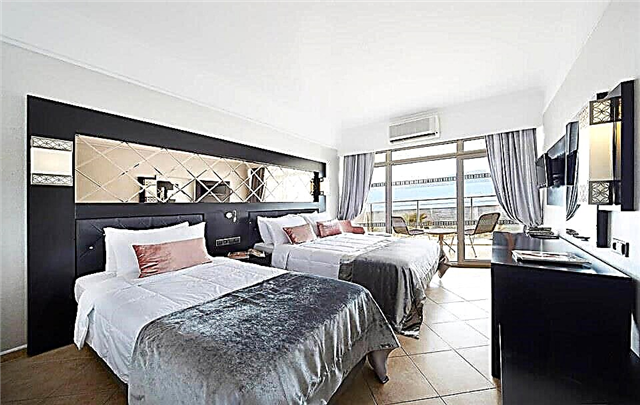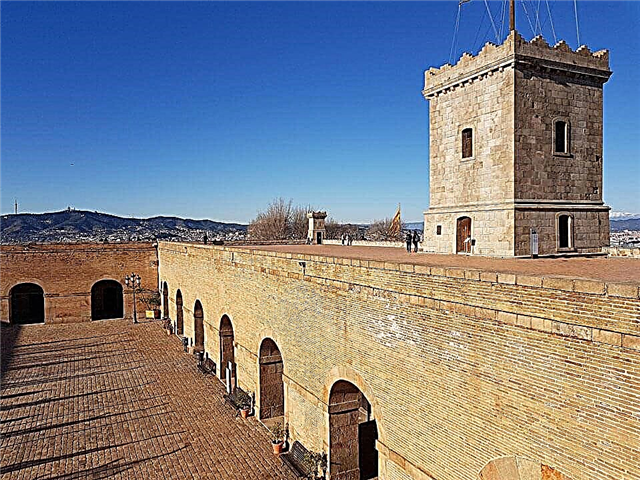For more than 600 years, the Assumption Cathedral in Moscow served as the main Orthodox church in Russia. Within its walls, the most important state and church ceremonies were carried out - the coronation and wedding of monarchs, the enthronement of the heads of the Russian Orthodox Church. At the beginning of the last century, the Assumption Cathedral lost its religious significance and turned into a tourist attraction.
Construction history
Archaeological excavations indicate that as early as the 12th century. on the site of the present cathedral there was a church. In the 13th century. at the behest of Prince Daniel of Moscow, the wooden structure was replaced by a stone one. The temple was the first building in the city to be built entirely of stone. The idea of creating a cathedral belonged to Metropolitan Peter. Construction work began on August 4, 1326. Initially, it resembled by its arrangement the St. George Church in the city of Yuryev-Polsky. Rough-hewn stones and smooth-hewn decorative fragments alternated in the masonry. The upper part was crowned with kokoshniks.
During the reign of Ivan III, the cathedral was badly dilapidated, and it became necessary to renovate it. Metropolitan Philip especially advocated for the construction of the new church. However, the erected building was destroyed by an earthquake in 1472. Prince Ivan III ordered to invite an experienced architect to avoid a repeat of failures. The famous Italian master Aristotle Fioravanti was called to Moscow as the chief architect. He brought to life the idea of creating the largest Orthodox church in Russia. As a prototype, it was decided to use the already existing similar cathedral in Vladimir:
- 5- head
- 5- apse
- 6-pillar

The material was white stone and red brick. The construction lasted 4 years (1475-1479). The painting of the walls inside the premises was carried out under the guidance of the famous icon painter Dionysius. Only small fragments of ancient frescoes have survived to this day. The church has repeatedly suffered from fires, therefore it was often restored and subjected to modifications. In the middle of the 16th century, the domes were covered with gilded copper sheets. At the beginning of the 17th century. the stone vault was completely dismantled and re-folded. At the same time, it was additionally reinforced with reinforced iron.
In 1812, Napoleon's army plundered and desecrated the cathedral. Most of his treasures were taken to France. The building was re-consecrated in 1813. At the end of the 19th and the beginning of the 20th century, a multi-stage restoration of the building took place. It was carried out by architects:
- S. K. Rodionov (1895–97)
- S. U.Soloviev (1900)
- I. P. Mashkov (1911-15)
In 1918, the Soviet government decided to close the Assumption Cathedral. A new stage in history began in 1955, when the building was given to house a museum exhibition. Since the end of the last century in the 90s, the cathedral has been a part of the historical and cultural museum-reserve "Moscow Kremlin". On certain holidays, the Patriarch of Moscow holds a liturgy.
A place for the wedding of kings
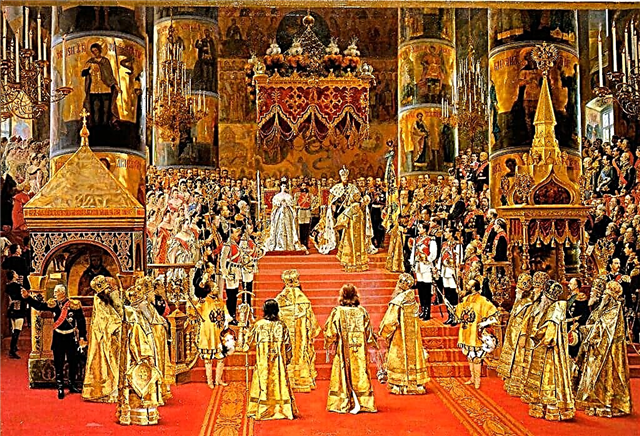
The first Russian monarch to receive a crown for the kingdom within the walls of the cathedral was Ivan IV, nicknamed the Terrible (1547). After the transfer of the capital from Moscow to St. Petersburg, the temple retained its status. It continued to carry out the coronation ceremonies of the emperors of Russia. A specially made royal prayer place (1551) testifies to the high role of the temple in the state life of the country. It received the name "Throne of Monomakh". The walls forming the base of the seat have a painting about the donation of the royal regalia by the Byzantine emperor Constantine to Vladimir Monomakh, the prince of Kiev.
At the foot of the throne there are artfully carved figures of fantastic animals. The pommel, in the form of a tent, is supported by 4 pillars decorated with floral patterns. The wooden dome over the throne is decorated with bas-reliefs of strange birds. The armchair was carved from walnut wood and painted by Novgorod craftsmen.
Architecture
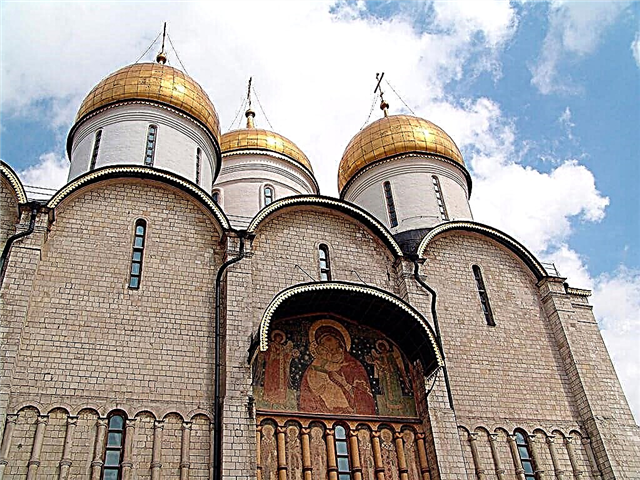
The creation of Aristotle Fioravanti harmoniously combines different architectural styles:
- Romanesque
- Byzantine
- Gothic
- Russian
Small stone blocks were used for construction. Due to this, the building looks like a monolithic structure. The façade is divided into equal parts. Narrow loopholes of windows stand out on the surface of the walls. Around the entire perimeter of the structure, an arcature-columnar belt stretches, consisting of decorative small arches resting on columns. The interior space is spacious and well-lit. The effect of openness is achieved through the use of round pillars supporting the dome and the creation of additional arches behind the iconostasis. In addition, during the construction of the building, innovations were tested:
- Metal fasteners inside the walls
- Single-brick cruciform vaults
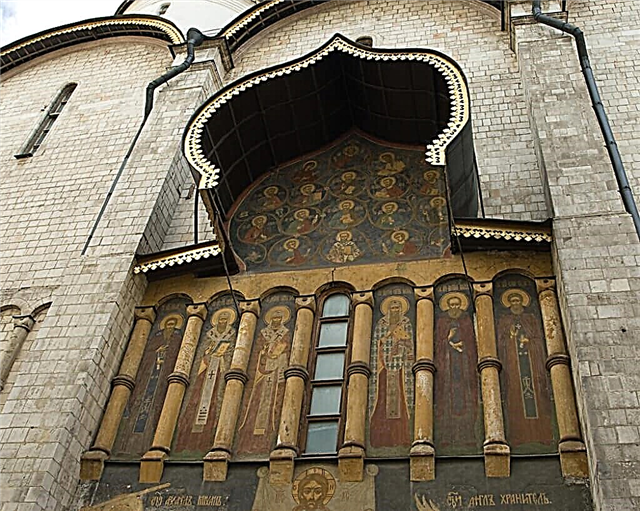
The top of the church is covered with domes. Their layout is somewhat displaced to the east. According to legend, the domes of the temple were first crowned with 8 terminal crosses.
Who built
The first builders of the main church in Moscow were Russian craftsmen Krivtsov and Myshkin. However, they were unable to complete the matter. Due to tremors, the walls of the church collapsed. It is believed that the cause was too weak fastening. Tsar Ivan III decided to seek help from recognized foreign architects. On his instructions, the embassy of Semyon Tolbuzin invited the hereditary Italian architect Ridolfo Fioravanti to Moscow. He was involved in the creation of religious buildings throughout Italy, and also worked in Hungary.
Before starting work on the church, the architect ordered to build a brick factory in the Moscow region. Thanks to the new building material, the walls have been noticeably strengthened. After the completion of the Assumption Cathedral, the architect stayed in Russia and was engaged in fortification. According to legend, he was entrusted with arranging the storage for the legendary Liberia (library) Ivan the Terrible.
Interior
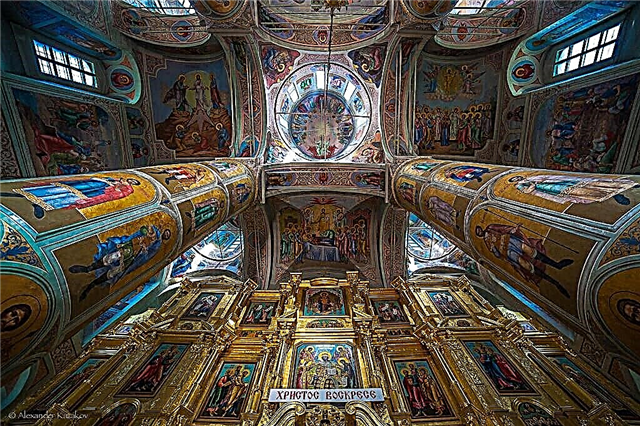
The first painting of the temple was created by an artel of painters, headed by Dionysius. However, during a massive fire, the frescoes were badly damaged. Artists from all over the country were invited to re-decorate the interior. 150 masters worked on the painting of the walls. They were led by Sidor Pospeev, Boris and Ivan Paisein. The work was completed in 1642-1644.
Painterly compositions consist of interrelated subjects:
- Under the dome is the vault of heaven
- Upper tier - paintings based on the Gospel
- Second tier - biography of the Virgin
- Lower tier - 7 Ecumenical Councils
There are 249 songs in total. The cathedral houses a huge collection of Orthodox icons. Among the glorified are - the Vladimir Mother of God, the Mother of God Hodegetria, the Assumption, the Savior of the Bright Eye, St. George, Trinity. The total height of the iconostasis is over 16 m. It has 5 tiers.
In front of the iconostasis:
- On the left side is the royal place
- On the right side - the seat of the patriarch
Another decoration of the temple is the chandelier, cast from silver to commemorate the victory over the Napoleonic army. The huge chandelier weighs 328 kg.
Shrines

During its existence, the temple has turned into a storage place for revered Christian shrines:
- The nail of the Lord is one of the 4 nails with which Jesus was crucified on the cross
- The rag of Christ's garment
- The image of the Vladimir Mother of God
- Icon of Our Lady of Hodegetria
- Staff of St. Peter, Metropolitan of Kiev and All Russia
The Lord's Robe came to Russian land in 1625 as a gift from the Shah of Persia to Tsar Mikhail Fedorovich. In commemoration of this, the Russian Orthodox Church instituted a celebration - the Position of the Lord's Robe. To preserve the relics, a special tent or canopy was created. It is a roof, similar to the cover over the Holy Sepulcher. The canopy consists of gilded and silver-plated copper plates.In addition, the openwork part is decorated with mica of different colors. The tent was erected in the southwestern part of the building.
Necropolis
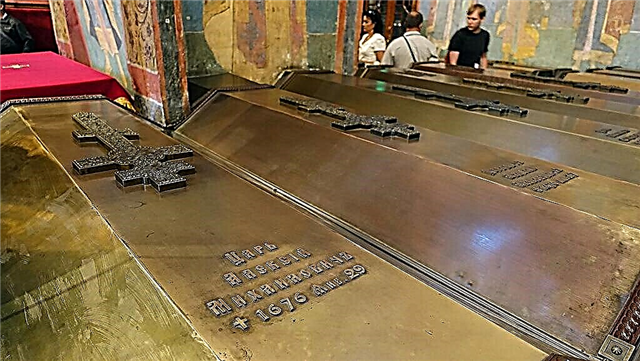
It was originally planned to turn the church into a burial vault for princes and Moscow metropolitans. The first burials date back to 1326. Subsequently, the role of the last refuge of princes and monarchs began to be played by another Kremlin cathedral - Arkhangelsk. And in the Church of the Assumption, they continued to bury the main clergy of the country.
Within the walls of the cathedral, there are 20 tombs of metropolitans and patriarchs (14-17 centuries). They are located along the north, west and south walls of the building. Old burial places are marked with small rectangular gravestones covered with metal sarcophagi. The patriarchs' graves are covered with stone slabs on which epitaphs are carved. Miraculous relics are placed in wooden crayfish decorated with metal plates.
Opening hours and visiting rules

The museum receives visitors daily (except Thursday):
- from 10 am to 6 pm (15.05-30.09)
- from 10 am to 5 pm (1.10-14.05)
During mass events on Red Square, the Kremlin museums are closed. The special location of the cathedral on the territory of the Kremlin dictates strict adherence to the rules for visitors. They regulate the requirements for excursionists:
- Mandatory presence of a ticket to the museum.
- Borovitsky and Troitsky gates work to pass people.
- Photography inside the museum is prohibited.
Where is it located and how to get there
The Church of the Assumption is located on the territory of the Kremlin. Its exact address is Moscow, Kremlin, Cathedral Square.
The easiest way is to take the metro. Nearest metro stations:
- "Okhotny Ryad"
- "Revolution square"
- "Theater"
- "Lenin's Library"
- "China town"
- Borovitskaya
- "Alexander Garden"
- "Arbatskaya"

